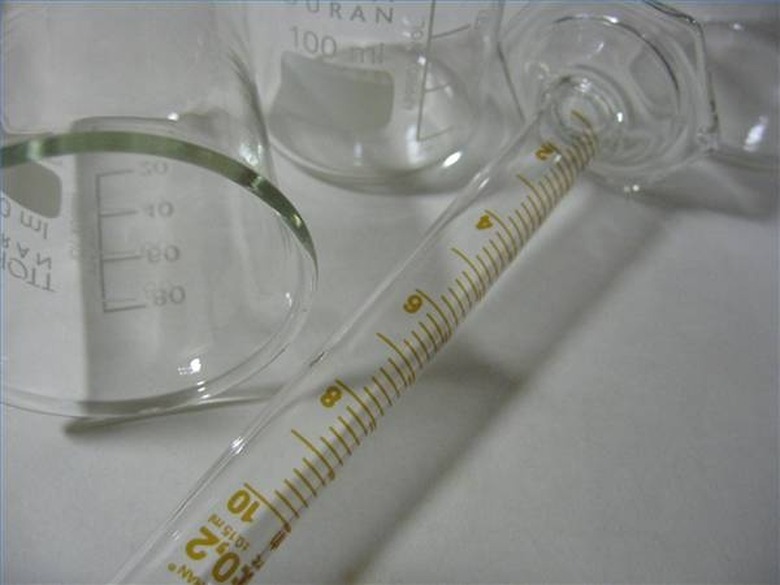How To Prepare Buffer Solutions
Buffer solutions resist changes in pH because they contain weak acid-base conjugates that neutralize H+ and OH- ions. Buffer solutions consist of weak acids or bases and the salt of that acid or base. Selection of an appropriate buffer system depends on the pH range for buffering. Most biological reactions occur at a pH range of 6 to 8. Phosphate buffers buffer over the pH range of 6.5 to 7.5. Carboxylic acid buffers are useful from pH 3 to 6. Borate buffers function from pH 8.5 to 10. Amino acid buffers such as glycine and histidine perform over a diversity of pH ranges. Tris buffer is one of the most commonly used buffer systems in biology labs. Calculations for a Tris buffer solution will be used in the following example, but the methodology applies to any buffer solution.
Step 1
Use the product of the final solution molarity and volume to determine moles of base required. For example, if 2 liters of a 0.1 M solution of Tris buffer is needed, then the number of moles of Tris required is:
0.1 moles/liter x 2 liters = 0.2 moles Tris base
Step 2
Calculate the mass of buffer required by multiplying the number of moles needed by the molecular weight of the base. For example, the mass of 0.2 moles of Tris base equals:
0.2 moles Tris x 121.1 g/mole Tris = 24.22 g Tris
Step 3
Measure the appropriate mass of base on a scale.
Step 4
Dissolve the base in distilled water using a magnetic stir bar and stirring hot plate. Dissolve it in a volume of water only slightly less than the final solution volume (950 to 975 mL for every liter of final solution). The pH of Tris buffer changes with concentration and needs readjustment if too small an initial volume is used. It is also best to prepare the buffer at the same temperature it will be used during the assay or experiment as Tris has large temperature dependant changes in pH.
Step 5
Titrate the aqueous Tris solution with 1 M hydrochloric acid using a pH meter.
Step 6
Bring the solution to final volume with distilled water in a volumetric flask.
Things Needed
- Distilled water
- Base powder or crystal
- Hydrochloric acid (HCl)
- Graduated cylinder
- Volumetric flask
- Magnetic stir bar
- Stirring Hot plate
- pH meter with probe
- Scale
- Calculator
TL;DR (Too Long; Didn't Read)
To save time when preparing a buffer solution, you can use premade buffer concentrates at the required pH and dilute for desired molarity and volume.
Prepare buffer solution at the same temperature it will be used to avoid significant pH changes.
Avoid time consuming pH adjustments, titrate only after diluting to the desired concentration. Dissolving in too small a volume will lead to repeated titrations.
Warning
Exercise caution when handling acids and bases.
Wear protective goggles.
Cite This Article
MLA
Boulianne, Carla. "How To Prepare Buffer Solutions" sciencing.com, https://www.sciencing.com/prepare-buffer-solutions-4625338/. 24 April 2017.
APA
Boulianne, Carla. (2017, April 24). How To Prepare Buffer Solutions. sciencing.com. Retrieved from https://www.sciencing.com/prepare-buffer-solutions-4625338/
Chicago
Boulianne, Carla. How To Prepare Buffer Solutions last modified March 24, 2022. https://www.sciencing.com/prepare-buffer-solutions-4625338/
